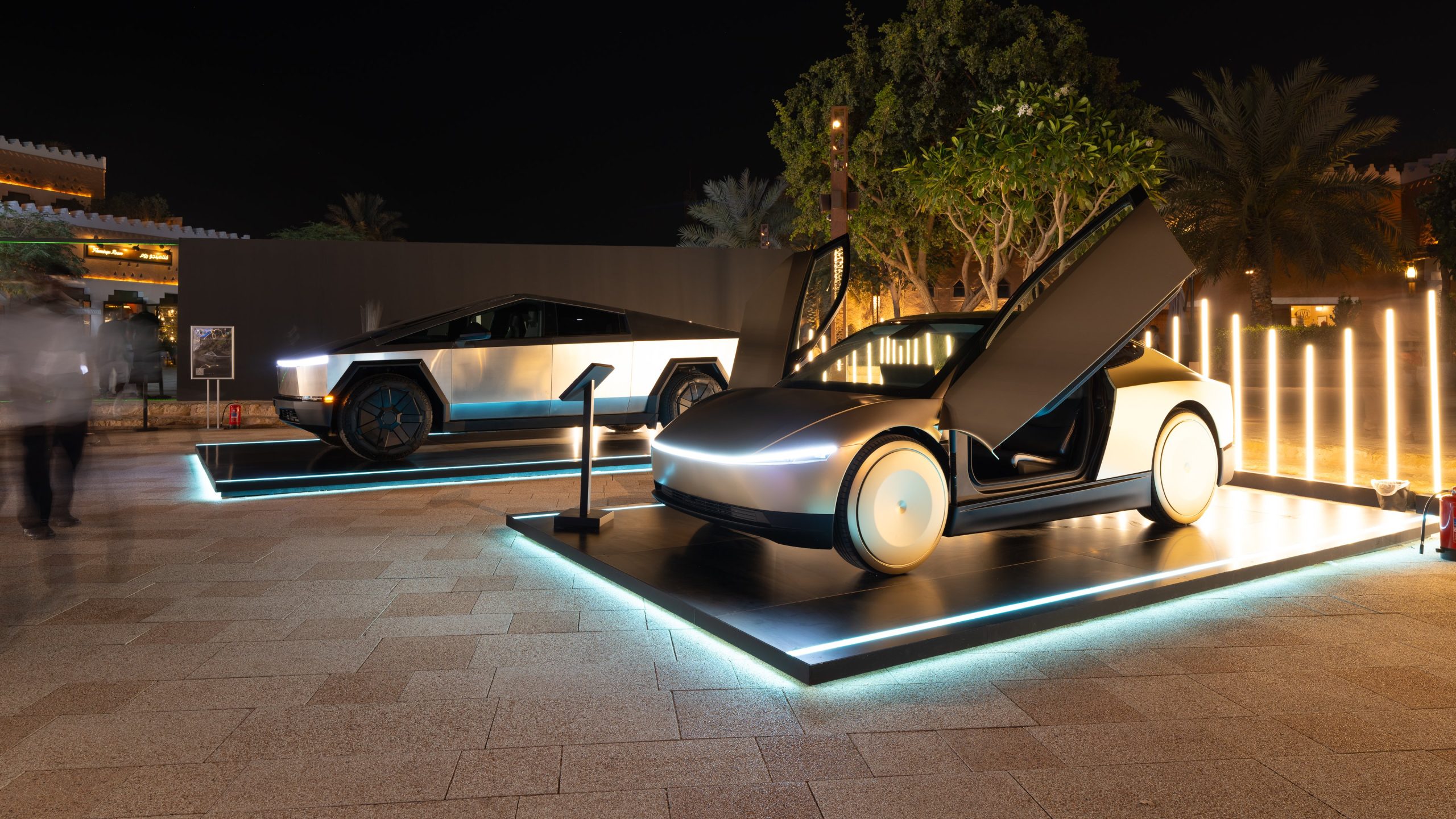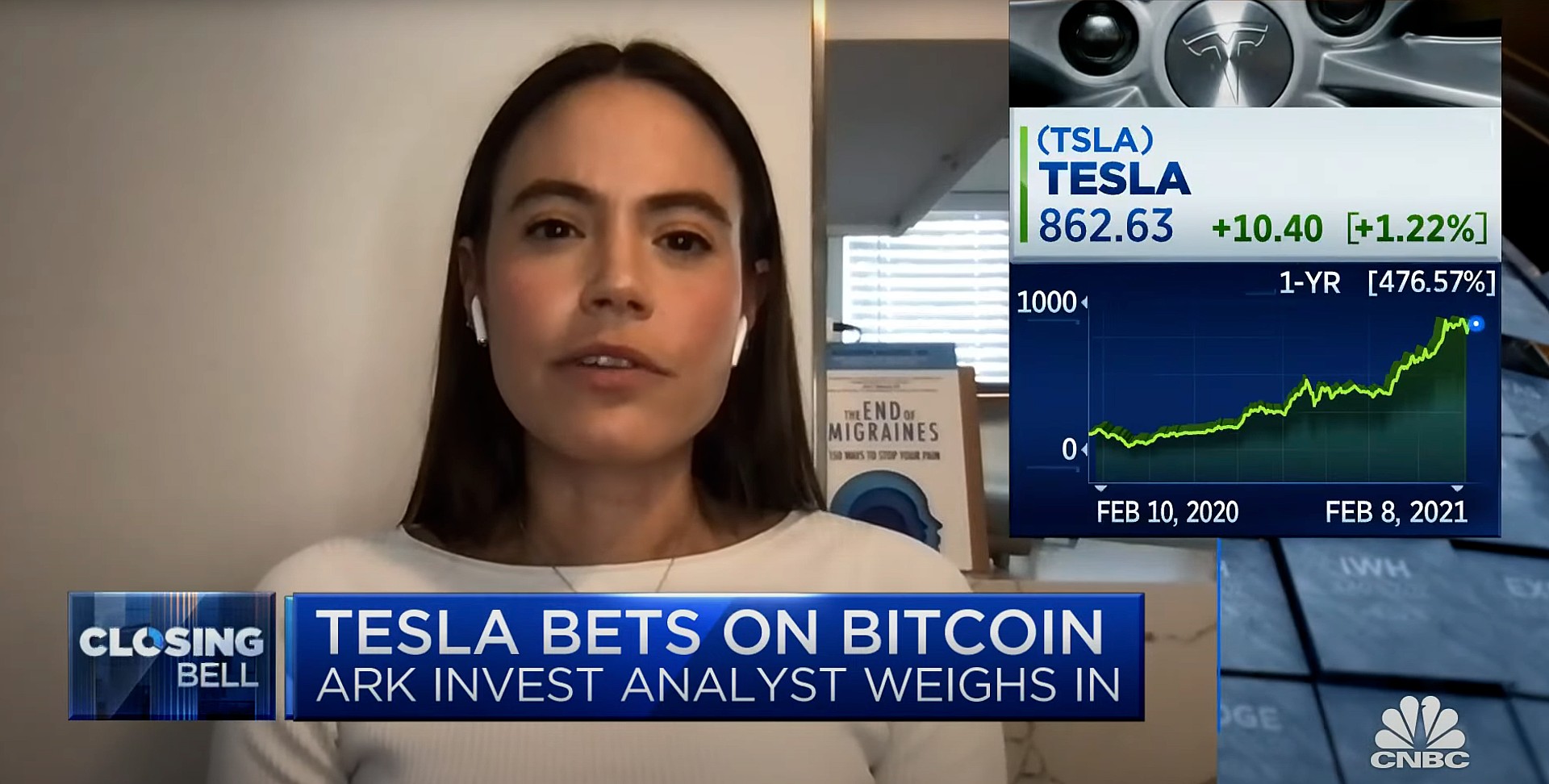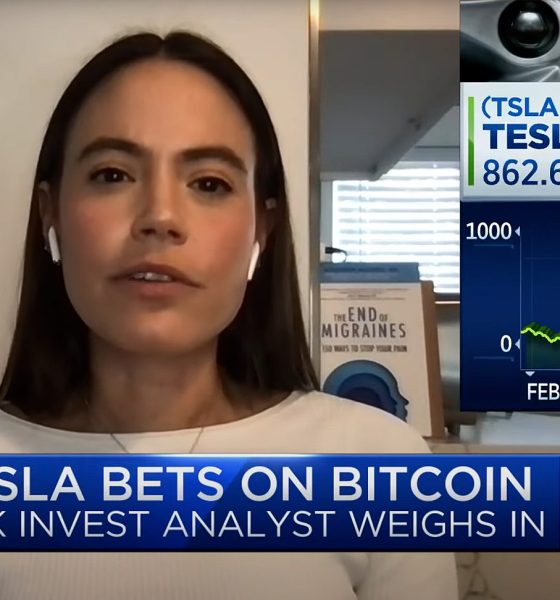Tesla’s (NASDAQ: TSLA) $1.5 billion purchase of Bitcoin, a move announced yesterday in a 10-K document filed with the SEC, was the most popular news surrounding the electric automaker on Monday. While some TSLA investors saw it as their time to get out of being shareholders, others look at it as an advantage in several ways. One person looking at the move from a bullish perspective is ARK Invest’s Tasha Keeney, who believes Tesla’s Bitcoin purchase has heavy advantages as the company moves toward a broader consumer base, especially in international markets.
Tesla’s BTC Purchase
In a 10-K filing with the Securities and Exchange Commission (SEC), Tesla announced it had purchased $1.5 billion in Bitcoin, a cryptocurrency that has massive value, trading at over $46,600 at the time of writing. Tesla added that it “may acquire and hold digital assets from time to time or long-term,” and that it anticipates the purchase of its cars and other products by using the cryptocurrency in the near future.
The move follows CEO Elon Musk’s vocal support of both Bitcoin and Dogecoin, two cryptocurrencies that have maintained huge upside potential over the past several months. Among the ever-growing list of digital currencies, Bitcoin and Dogecoin are among the most popular in 2021, mainly because of ongoing celebrity support.
In the past several years, Bitcoin has become widely popular, especially after a meteoric rise in value in 2017 and 2018 that made it a household name. Early investors used Bitcoin to purchase goods from the internet in an untraceable manner. Now, more retail companies are working on accepting the crypto as a form of payment for everything from a pizza to a Rolex watch.
“It is a very serious move from [Tesla] – Keeney
Tasha Keeney, an analyst for Ark Invest, stated that Tesla’s move to purchase Bitcoin is one that aligns with the company’s recent Big Ideas Report. One of the most significant advantages to purchasing Bitcoin for Tesla is the versatility of the cryptocurrency, especially when doing business internationally. “Using Bitcoin as corporate cash, especially if you’re doing business in many different countries with many different foreign currencies…instead of dealing with the complication and the treasury risk, you can instead do this with Bitcoin,” Keeney said. “We think it makes sense from a corporate cash standpoint, and actually, we’ve done some analysts to say that if 1% of all the cash from the companies in the S&P 500 were to be converted into Bitcoin for corporate treasury purposes, this could actually increase the price by a meaningful amount, by about $40,000.”
Additionally, when operational in other countries, Tesla’s planned ride-hailing Robotaxi service could avoid hurdles and complications in payment by using a universal currency instead of multiple different foreign currencies. Keeney says the payment function could be void of conversion issues if customers used a single form of payment instead of dealing with various currencies in each region.
Tesla bull ARK Invest estimates autonomous ride-hailing to generate over $1T in revenue by 2030
A Publicity Move? ARK doesn’t think so
Bitcoin is no longer a risky or unusual form of payment. Many large companies accept the crypto as a form of currency, and Tesla just plans to be the latest one to accept it. “[Their move] is validated by other firms doing the same thing,” Keeney added during an interview with CNBC.
With Tesla focused on a widespread and quickly accelerating rollout of its products in foreign countries, Bitcoin’s international usage seems to be an advantage that the automaker can use. From a treasury perspective, it doesn’t make sense to deal with so many different foreign currencies, and Bitcoin’s universal acceptance across the world gives Tesla versatility as it expands. With plans to enter the highly elusive Indian market shortly, and expansions in Singapore, Israel, among several other countries, Tesla is technically making a move that supports its goal: accelerate the world’s transition to sustainable energy.
Tesla’s somewhat early adoption of Bitcoin as a payment method and as an internal investment also holds other benefits, Keeney says. With Tesla joining the Bitcoin movement, it, along with other companies, could experience a tailwind in growth from its influence. Other companies are bound to either invest or accept Bitcoin as a currency later on. The entities that got in before it was widely-accepted could benefit from a surge in valuation after it continues to be looked at as a payment method.
“Being one of the first companies to invest in Bitcoin, to transact in Bitcoin, actually gives them sort of an advantage to really lay that infrastructure as it becomes increasingly important. And again, as other firms might do it, because we feel there will be the need for the infrastructure to be set up. So, [Tesla] will be one of the first players to figure this out,” Keeney stated.
Check out Keeney’s interview with CNBC below.
Disclosure: Joey Klender is a TSLA shareholder. He does not hold any BTC and has no intentions to open any positions within 72 hours.

Investor's Corner
SpaceX IPO is coming, CEO Elon Musk confirms
However, it appears Musk is ready for SpaceX to go public, as Ars Technica Senior Space Editor Eric Berger wrote an op-ed that indicated he thought SpaceX would go public soon. Musk replied, basically confirming it.

Elon Musk confirmed through a post on X that a SpaceX initial public offering (IPO) is on the way after hinting at it several times earlier this year.
It also comes one day after Bloomberg reported that SpaceX was aiming for a valuation of $1.5 trillion, adding that it wanted to raise $30 billion.
Musk has been transparent for most of the year that he wanted to try to figure out a way to get Tesla shareholders to invest in SpaceX, giving them access to the stock.
He has also recognized the issues of having a public stock, like litigation exposure, quarterly reporting pressures, and other inconveniences.
However, it appears Musk is ready for SpaceX to go public, as Ars Technica Senior Space Editor Eric Berger wrote an op-ed that indicated he thought SpaceX would go public soon.
Musk replied, basically confirming it:
As usual, Eric is accurate
— Elon Musk (@elonmusk) December 10, 2025
Berger believes the IPO would help support the need for $30 billion or more in capital needed to fund AI integration projects, such as space-based data centers and lunar satellite factories. Musk confirmed recently that SpaceX “will be doing” data centers in orbit.
AI appears to be a “key part” of SpaceX getting to Musk, Berger also wrote. When writing about whether or not Optimus is a viable project and product for the company, he says that none of that matters. Musk thinks it is, and that’s all that matters.
It seems like Musk has certainly mulled something this big for a very long time, and the idea of taking SpaceX public is not just likely; it is necessary for the company to get to Mars.
The details of when SpaceX will finally hit that public status are not known. Many of the reports that came out over the past few days indicate it would happen in 2026, so sooner rather than later.
But there are a lot of things on Musk’s plate early next year, especially with Cybercab production, the potential launch of Unsupervised Full Self-Driving, and the Roadster unveiling, all planned for Q1.
Investor's Corner
Tesla Full Self-Driving statistic impresses Wall Street firm: ‘Very close to unsupervised’
The data shows there was a significant jump in miles traveled between interventions as Tesla transitioned drivers to v14.1 back in October. The FSD Community Tracker saw a jump from 441 miles to over 9,200 miles, the most significant improvement in four years.

Tesla Full Self-Driving performance and statistics continue to impress everyone, from retail investors to Wall Street firms. However, one analyst believes Tesla’s driving suite is “very close” to achieving unsupervised self-driving.
On Tuesday, Piper Sandler analyst Alexander Potter said that Tesla’s recent launch of Full Self-Driving version 14 increased the number of miles traveled between interventions by a drastic margin, based on data compiled by a Full Self-Driving Community Tracker.
🚨 Piper Sandler reiterated its Overweight rating and $500 PT on Tesla $TSLA stock
Analyst Alexander Potter said FSD is near full autonomy and latest versions showed the largest improvement in disengagements, from 440 miles to 9,200 miles between critical interventions pic.twitter.com/u4WCLfZcA9
— TESLARATI (@Teslarati) December 9, 2025
The data shows there was a significant jump in miles traveled between interventions as Tesla transitioned drivers to v14.1 back in October. The FSD Community Tracker saw a jump from 441 miles to over 9,200 miles, the most significant improvement in four years.
Interestingly, there was a slight dip in the miles traveled between interventions with the release of v14.2. Piper Sandler said investor interest in FSD has increased.
Full Self-Driving has displayed several improvements with v14, including the introduction of Arrival Options that allow specific parking situations to be chosen by the driver prior to arriving at the destination. Owners can choose from Street Parking, Parking Garages, Parking Lots, Chargers, and Driveways.
Additionally, the overall improvements in performance from v13 have been evident through smoother operation, fewer mistakes during routine operation, and a more refined decision-making process.
Early versions of v14 exhibited stuttering and brake stabbing, but Tesla did a great job of confronting the issue and eliminating it altogether with the release of v14.2.
Tesla CEO Elon Musk also recently stated that the current v14.2 FSD suite is also less restrictive with drivers looking at their phones, which has caused some controversy within the community.
Although we tested it and found there were fewer nudges by the driver monitoring system to push eyes back to the road, we still would not recommend it due to laws and regulations.
Tesla Full Self-Driving v14.2.1 texting and driving: we tested it
With that being said, FSD is improving significantly with each larger rollout, and Musk believes the final piece of the puzzle will be unveiled with FSD v14.3, which could come later this year or early in 2026.
Piper Sandler reaffirmed its $500 price target on Tesla shares, as well as its ‘Overweight’ rating.
Investor's Corner
Tesla gets price target boost, but it’s not all sunshine and rainbows

Tesla received a price target boost from Morgan Stanley, according to a new note on Monday morning, but there is some considerable caution also being communicated over the next year or so.
Morgan Stanley analyst Andrew Percoco took over Tesla coverage for the firm from longtime bull Adam Jonas, who appears to be focusing on embodied AI stocks and no longer automotive.
Percoco took over and immediately adjusted the price target for Tesla from $410 to $425, and changed its rating on shares from ‘Overweight’ to ‘Equal Weight.’
Percoco said he believes Tesla is the leading company in terms of electric vehicles, manufacturing, renewable energy, and real-world AI, so it deserves a premium valuation. However, he admits the high expectations for the company could provide for a “choppy trading environment” for the next year.
He wrote:
“However, high expectations on the latter have brought the stock closer to fair valuation. While it is well understood that Tesla is more than an auto manufacturer, we expect a choppy trading environment for the TSLA shares over the next 12 months, as we see downside to estimates, while the catalysts for its non-auto businesses appear priced at current levels.”
Percoco also added that if market cap hurdles are achieved, Morgan Stanley would reduce its price target by 7 percent.
Perhaps the biggest change with Percoco taking over the analysis for Jonas is how he will determine the value of each individual project. For example, he believes Optimus is worth about $60 per share of equity value.
He went on to describe the potential value of Full Self-Driving, highlighting its importance to the Tesla valuation:
“Full Self Driving (FSD) is the crown jewel of Tesla’s auto business; we believe that its leading-edge personal autonomous driving offering is a real game changer, and will remain a significant competitive advantage over its EV and non-EV peers. As Tesla continues to improve its platform with increased levels of autonomy (i.e., hands-off, eyes-off), it will revolutionize the personal driving experience. It remains to be seen if others will be able to keep pace.”
Additionally, Percoco outlined both bear and bull cases for the stock. He believes $860 per share, “which could be in play in the next 12 months if Tesla manages through the EV-downturn,” while also scaling Robotaxi, executing on unsupervised FSD, and scaling Optimus, is in play for the bull case.
Will Tesla thrive without the EV tax credit? Five reasons why they might
Meanwhile, the bear case is placed at $145 per share, and “assumes greater competition and margin pressure across all business lines, embedding zero value for humanoids, slowing the growth curve for Tesla’s robotaxi fleet to reflect regulatory challenges in scaling a vision-only perception stack, and lowering market share and margin profile for the autos and energy businesses.”
Currently, Tesla shares are trading at around $441.










